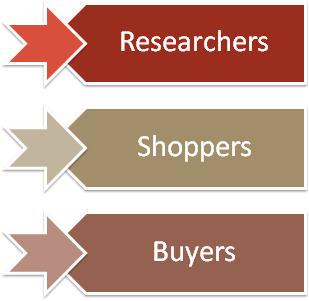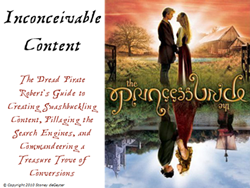 One of the first things you need to do when developing your website is to perform research on your target audience. Without it, you won’t know who you are trying to sell to, or how to reach them with your content.
One of the first things you need to do when developing your website is to perform research on your target audience. Without it, you won’t know who you are trying to sell to, or how to reach them with your content.
The best way to attract the specific customers you want and make sure you are meeting the needs of your audience is to write your content specifically for them. But even knowing who your audience is doesn’t mean you’re able to speak to them on their level unless you know where they are in the buying process.
Content designed to inform won’t do a good job of selling, just as content designed to sell isn’t what people need when they want to be informed. Therefore different pages of your site need to be targeted, not for a different audience, but the same audience in different places of the buying cycle.
There are essentially three phases of the buying cycle that need to be addressed: Researchers, Shoppers and Buyers. Generally, people start in the research phase, then move into shopping mode, and finally are prepared to buy the product or service they are in need of. A single site can help these people move from one phase of the buying cycle to another and, hopefully, to the goal of getting a conversion.
Not everybody will land on your site starting with the research phase. Some will hit only as they are ready to buy, some will shop and leave, and others will be there for the duration of the process while also moving in and out of other sites as they go from research to buy.

Researchers
Most people start out in the research mode as they get an inkling in their mind that there is a product or service they want. Unfortunately, they don’t quite know what they want or what will meet their specific needs. So, they set out to do some research.
A significant majority of searches performed every day are informational based – where people are looking to gain some knowledge about something, not necessarily looking to buy a product or service. That’s not to say that these people don’t become shoppers at some point, but research is where they start.
Broad category pages and blog posts are generally the best place to target these types of searchers. They are looking for content that helps them gain a better grasp on the topic, so you need to write content that provides the information they need. Don’t try to sell them… just inform them with whatever information is necessary for them to begin to be convinced enough to move to the next phase.
Blogs are especially good at hitting this because information-based searches are often very broadly focused. As informational searches get more specific, the topics (and keywords) you can reach them with will increase as well.
“Research” content is the bait you use to get people to your site. It allows you to become a source of information for their query and gives you the ability to start earning trust.
Shoppers
The next phase people move into is the shopping phase. This is when they know they want to buy something, only now they are trying to learn more about what solutions are out there that will meet their needs.
Think of this as window shopping. They are looking around trying to figure out what they like, don’t like, or has the “features” that will help them accomplish their goals. They are comparing products, looking at the details, and using the new information gathered to help them narrow down their list to only what they believe will give them the best satisfaction.
You generally want shoppers to land on your main product category pages. This will give them some information and a whole lot of products to explore. If you have multiple product sub-categories within categories, use your keyword research to help you determine which sub-categories are the best place to land shoppers, based on how they searched.
You want to optimize your category pages so shoppers land closest to the products that meet their search query without pushing them to a specific product. Pushing them to a product page before they have all the information they need will simply push them away from the sale.
Buyers
Buyers are those who are using the search engine to deliver them the right product with the right features. They are performing very specific searches designed to get them to specific product pages that match their criteria for a purchase.
These guys are ready to buy, and there is no need to try to pre-sell them. Getting them to product pages that have specific details and features listed is the fastest route to a sale. If you deliver these searchers to informational pages or even category pages, you run the risk of sidetracking your visitors. You’ll move them out of buy mode and back into shop mode. Instead of getting a sale, you just have another window shopper.
Knowing your audience is important. But knowing them in broad, general terms is not a substitute for knowing what they need when they search. Obviously, knowing the need of each searcher is impossible, but you can optimize your pages to meet the needs of your audience at large depending on where they are in the research, shop, and buy process.
This allows you to give your visitors more of what they want, when they want it. Get the right content to them early in the buying cycle, and they are more likely to stick with you through the buying process. Get them different content late in the buying cycle and they may buy now! Of course, this is providing that what they want earns those trust points that will turn into sales. Sales are not made by the products you offer… it’s in the content you write.
 This post was inspired from The Princess Bride themed presentation I gave in early 2010 at SEMpdx’s Searchfest titled Inconceivable Content: The Dread Pirate Robert’s Guide to Creating Swashbuckling Content, Pillaging the Search Engines, and Commandeering a Treasure Trove of Conversions. If you enjoyed this post you also might enjoy other posts inspired from the same. Search for “inconceivable content” on this blog to find them all.
This post was inspired from The Princess Bride themed presentation I gave in early 2010 at SEMpdx’s Searchfest titled Inconceivable Content: The Dread Pirate Robert’s Guide to Creating Swashbuckling Content, Pillaging the Search Engines, and Commandeering a Treasure Trove of Conversions. If you enjoyed this post you also might enjoy other posts inspired from the same. Search for “inconceivable content” on this blog to find them all.

One Response to Does Your Content Know Where Your Audience Is?